A Brief History of Milwaukee Avenue, Part 1: an Indian Trail Becomes Dinner Pail Avenue

Milwaukee/Kimball/Diversey [John Morris/Chicago Patterns]
The beauty and lore of this avenue was captured over a century ago in a book by a Jefferson Park resident:
What Soho is to London this diagonal avenue is to the Garden City. By turns the Greek, Italian, German, Scandinavian, Russian, Lithuanian and Pole monopolize the street signs, the corner news-stands, the sidewalks and the cars, or proclaim to the passing nose one aspect of their national delicacies.
Every half-section line exhibits in its ganglia, as the crossing of the thoroughfares, a sharp-angled picturesque frontage, akin to Seven Dials or Five Points in their palmy days.
—Alfred Bull, amateur historian describing Milwaukee Avenue in 1911
In the first part of this series, we’ll look at the early history of Milwaukee Avenue, and follow it until the boom years of the 1920s. Next we’ll cover the Chicago School of architecture, and later, the transition to the Machine Age and Art Deco.
Contents
- Intro
- A Road of Many Names
- Transit Brings Economic Growth
- Immigration Forms Neighborhood Identities
- “Dinner Pail Avenue”
- An Evolving Study of Housing Types
- Nickelodeons and Movie Palaces
- Milwaukee Avenue after Dinner Pail Avenue
The most obvious feature of this arterial road is its path, running diagonal to the city’s grid network of streets.
Though many believe the grid system came as a result of planning after the Great Fire, it actually dates to the original surveying of the city in 1830. This early date of the grid makes this conspicuous diagonal path (especially to pedestrians) even more puzzling.
The simplest answer to this minor riddle is the correct one–Milwaukee Avenue existed long before the City of Chicago did.
A Road of Many Names
Like street names all over the country, its namesake comes from another city: Milwaukee. Not specifically because it leads there, though it does via a circuitous route.
Before 1829: Indian Trail
Milwaukee Avenue originated as an indian trail, used for centuries by the original inhabitants of Illinois. The path may have been originally created by animals seeking the waters of Lake Michigan.
The 1829 Treaty of Prairie du Chien took the land away from Native Americans, opening up potential for land ownership and profit. After the treaty, European settlers arrived in droves to areas northwest of the city in the early 1830s.
1849: Northwestern Plank Road
With newly available land acquired from its original inhabitants, settlers headed northwest in search of opportunity. At best, the path was slow and difficult to navigate. At worst, travel was impossible.
Construction of the Northwestern Plank Road began in 1849, charging travelers for use.

From The Town of Jefferson, by Alfred Bull, photograph by William Landshaft
1890: The End of Tolls: a Mob Destroys Toll House and Gate
In 1865, A.J. Snell purchased the old plank road and added gravel. For decades he operated a profitable system of exacting tolls from those passing through the Northwest Turnpike, but rarely invested in its upkeep or improvement.
By the late 1880s, it was referred to as Snell toll road. The system of tolls was despised by farmers and other residents who had no other option to reach their destination. Snell was murdered in an apparent robbery in 1889, and his heirs continued collect tolls despite the poor condition and legal challenges to its existence.
In 1890 (contradictory to the date in the above photo), a mob of 200 or so warned the gatekeeper to exit the building, and burned it down in glee and celebration.
A court later ruled against the Snell heirs. The court stated current residents had no choice in the selection process of choosing a company to maintain the road, as result of development growing rapidly around it.
![Illustration of where toll house was once located on Fullerton and Milwaukee. [Chicago Tribune, Mar 26, 1911]](http://chicagopatterns.com/wp-content/uploads/2016/06/fullerton_milwaukee_toll-900x408.jpg)
Illustration of where toll house was once located on Fullerton and Milwaukee, 20 years after it was destroyed by a mob. [Chicago Tribune, Mar 26, 1911]
Transit Brings Economic Growth

Advertisement from 1875 Holland’s Milwaukee Avenue Directory
1874: Downtown to North/Damen in 30 Minutes
Before the removal of the toll house, transit laid the foundation of rapid access to Downtown from the Northwest Side. The Steinhouse’s Citizen’s Omnibus Line (above) provided horse-drawn coaches in 1874, with a travel time of about 30 minutes from Downtown to North and Damen Avenues.
1895: The First Electric Elevated Road Comes to Logan Square
The removal of tolls, addition of streetcars, and the new Milwaukee Elevated Line transformed Milwaukee Avenue at the turn of the century into a bustling thoroughfare that provided quick access from suburban neighborhoods to downtown.
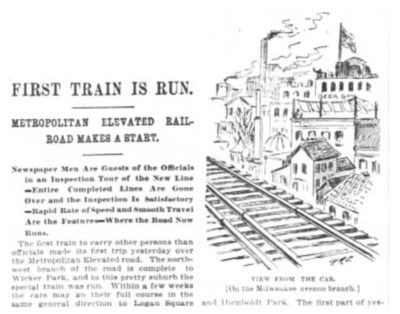
Article highlighting the first run of the Metropolitan Elevated’s new Milwaukee Avenue branch, April 18, 1895 Chicago Tribune
In 1895 the Metropolitan West Side Elevated Railroad built the first electric elevated line in Chicago. This electric line had branches that left downtown for Garfield Park, Humboldt Park, Logan Square, and Douglas Park.
Several branches of the original Metropolitan Elevated operate today along the Blue and Pink Lines.
![California Blue Line station prior to 2014 restoration [John Morris/Chicago Patterns]](http://chicagopatterns.com/wp-content/uploads/2016/06/california-1-900x600.jpg)
California Blue Line platform prior to 2014 restoration [John Morris/Chicago Patterns]
![California - Blue Line station entrance after renovation. [John Morris/Chicago Patterns]](http://chicagopatterns.com/wp-content/uploads/2016/06/california-900x600.jpg)
California – Blue Line station entrance after renovation in 2014. [John Morris/Chicago Patterns]
Immigration Forms Neighborhood Identities
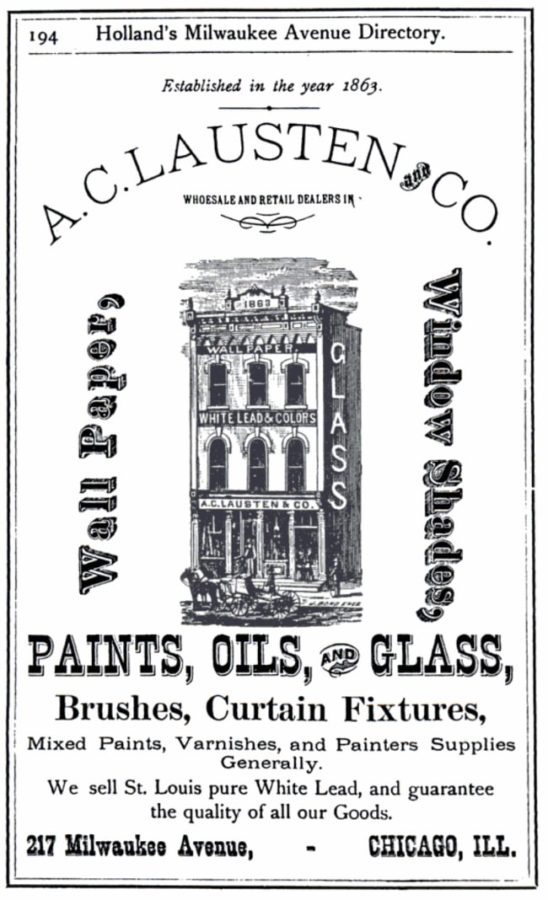
Ad for A.C. Lausten and Company, from 1875 Holland’s Milwaukee Avenue Directory
1860s-1910s: German Immigrants Arrive
The early ethnic makeup of Milwaukee Avenue’s settlement was largely German, after several waves of immigration to Chicago. New German immigrants established saloons, hardware stores, bakeries, and clothing stores.
Along Milwaukee Avenue closer to Downtown in the 1870s-1890s, the German population was so prevalent that real estate advertisements appeared in both German and English.
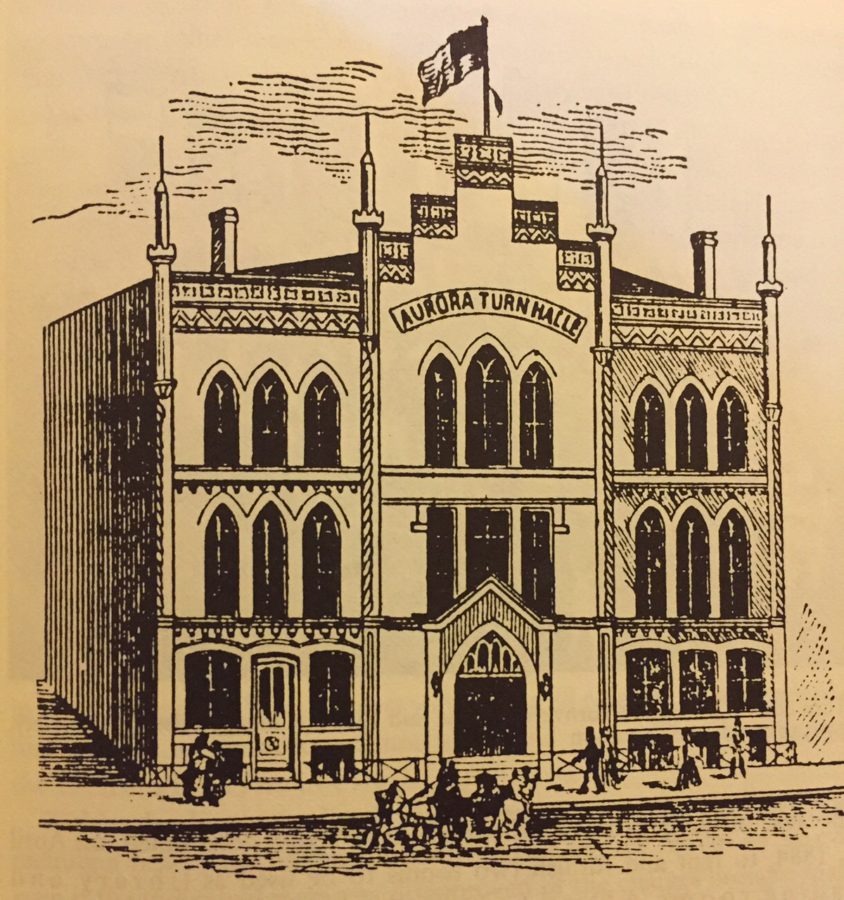
Aurora Turner Hall built in 1868 at Milwaukee and Huron, no longer extant
Many of the architectural artifacts of German culture were social halls, such as Aurora Turner Hall (above).
Oddfellows Halls, Masonic Halls, and Turner Halls (Turnverein) were forming as a place for leisure, organization, and support. For more on the Turnverein, see our recent article Chicago’s Forgotten Turner Halls: Turnverein Vorwaerts.
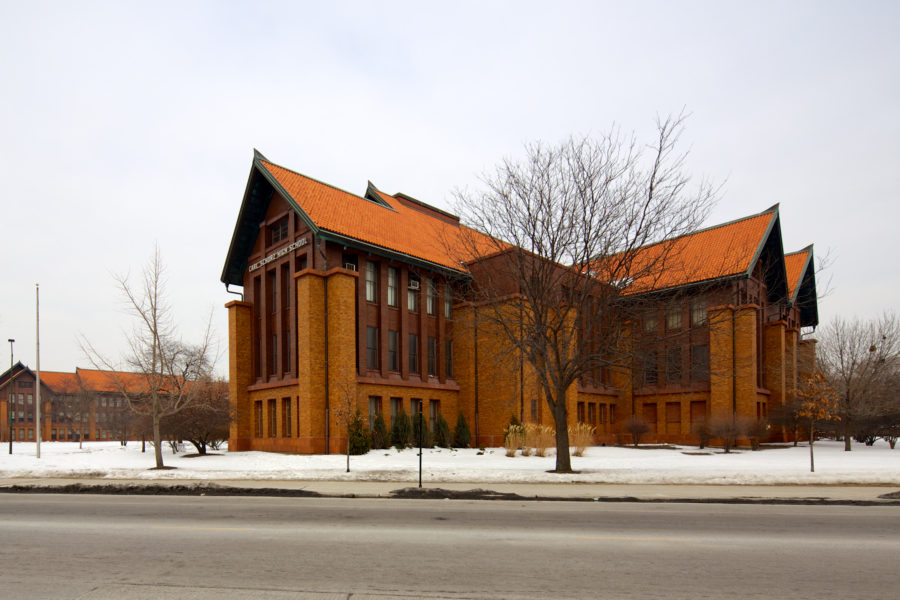
Carl Schurz School [John Morris/Chicago Patterns]
One of the remnants of this rapid expansion is the nationally landmarked Carl Schurz High School at Milwaukee and Addison.
An expanding population needed a larger school, and Carl Schurz would be the namesake for the new school. Schurz, a German immigrant, had no connection to Chicago but was a General in the Civil War, a Senator, and Secretary of the Interior, among other titles.
Designed by Dwight Perkins, this near-perfectly preserved structure represents a blending of the Chicago School and Prairie School styles of architecture. Today, roughly 1,200 students are enrolled.
The Chicago School is the next topic we’ll cover on this series of architecture history of Milwaukee Avenue.
![Former Norwegian Baptist Church on Wrightwood near Milwaukee. Inscription is in Danish, which was used in written form prior to the 20th century. [John Morris]](http://chicagopatterns.com/wp-content/uploads/2016/06/norw_baptist-675x900.jpg)
Former Norwegian Baptist Church on Wrightwood near Milwaukee. Inscription is in Danish, which was used in written form prior to the 20th century. [John Morris/Chicago Patterns]
1870s-1910s: Scandinavians Settle in Logan Square
Toward the end of the 19th century, Scandinavians arrived to neighborhoods along Milwaukee, in particular the Norwegians in Logan Square.
![Minnekirken Norwegian Lutheran Church [John Morris/Chicago Patterns]](http://chicagopatterns.com/wp-content/uploads/2016/06/minnekirken-900x600.jpg)
Minnekirken Norwegian Lutheran Church [John Morris/Chicago Patterns]
![Restored art glass windows at Minnekirken [John Morris/Chicago Patterns]](http://chicagopatterns.com/wp-content/uploads/2016/06/minnekirken-1-900x600.jpg)
Restored art glass windows at Minnekirken [John Morris/Chicago Patterns]
Minnekirken holds services in both Norwegian and English during the same service. The art glass windows of the church were recently restored with help from Logan Square Preservation.
Though most of the Norwegian families and their descendants left Logan Square for suburban areas, there are still a few in the neighborhood.
![1913 Polish Roman Catholic Union and the Polish Museum of America building, a National Landmark [John Morris/Chicago Patterns]](http://chicagopatterns.com/wp-content/uploads/2016/05/museum-900x600.jpg)
1913 Polish Roman Catholic Union and the Polish Museum of America building, a National Landmark [John Morris/Chicago Patterns]
1880s-1910s: Early Formation of the Polish Corridor
More [Polish] settlers came after the inaugurations of Bismarck’s anti-Polish policy during the 70s, which drove out some 30,000 Poles from Prussian Poland. After that, the numbers that came in gradually increased until there were 52,000 foreign-born Poles in 1890, and 250,000 in July, 1903! […] The 1930 census places the figure well over 400,000.
— Anthony C. Tomczak, Poles in Chicago (1933)
Milwaukee Avenue is perhaps best known for its large Polish population, from West Town to Jefferson Park and well into the suburbs. Some of the reasons for Milwaukee Avenue’s attraction to Polish immigrants was the growth of industry, as well as the ease of access to industrial jobs downtown.
![Holy Trinity Roman Catholic Church [John Morris/Chicago Patterns]](http://chicagopatterns.com/wp-content/uploads/2016/06/trinity-900x600.jpg)
Holy Trinity Roman Catholic Church [John Morris/Chicago Patterns]
![Polskie Centrum Medyczne at Milwaukee and Monticello [John Morris/Chicago Patterns]](http://chicagopatterns.com/wp-content/uploads/2016/06/centrum_med-900x599.jpg)
Polskie Centrum Medyczne at Milwaukee and Monticello in Avondale [John Morris/Chicago Patterns]
Grand houses of worship, businesses, and restaurants cater to a group that continues to arrive in Chicago today. Though immigration has slowed significantly, Poland remains the second highest country of origin for immigrants in Chicago and Illinois.
We’ll continue to study the legacy of Polish immigration to Chicago in the third part of this series.
![Front page of the Tribune in 1911 highlights an area rapidly growing [Chicago Tribune, March 26, 1911]](http://chicagopatterns.com/wp-content/uploads/2016/06/milwaukee_boom-900x701.jpg)
Front page of the Tribune in 1911 highlights an area rapidly growing [Chicago Tribune, March 26, 1911]
Dinner Pail Avenue
The rapid arrival of so many immigrants to Milwaukee Avenue around the turn of the century led to an economic boom. The wealth created by immigrants attracted to transit and housing built upon itself, leading to Milwaukee Avenue becoming the second largest economic district in Chicago, outside of Loop (noted above).
With many of the area’s residents traveling during rush hour for destinations along Milwaukee Avenue and places downtown, it earned the nickname Dinner Pail Avenue.
Clerical, industrial, administrative, and other workers set off with a dinner pail in tow, leading to its one-time nickname:
The Dinner Pail avenue army is only one of a hundred battalions marching on the downtown section of Chicago at this moment from every part of the city. They pour out of modest homes, from brick and wood cottages, from back alleys and side streets, from modest workingmen’s flats, to swell the invasion. […] Nearly every unit in this Milwaukee avenue host carries its means of sustenance with it, and as we watch we see that the variety of the dinner pails alone is astonishing.
— Josiah Seymour Currey, Manufacturing and Wholesale Industries of Chicago, Volume 1 (1918)
![Former Central Furniture Mart at Milwaukee and Wood in 2014 [John Morris/Chicago Patterns]](http://chicagopatterns.com/wp-content/uploads/2016/06/central_furniture-900x600.jpg)
Former Central Furniture Mart at Milwaukee and Wood in 2014 [John Morris/Chicago Patterns]
The Legacy Industries Of Milwaukee Avenue: Clothing and Furniture
Along Milwaukee, many of the industries that arose were centered around clothing and furniture. Though a few are active today, they are becoming increasingly scarce as a result of rising land values.
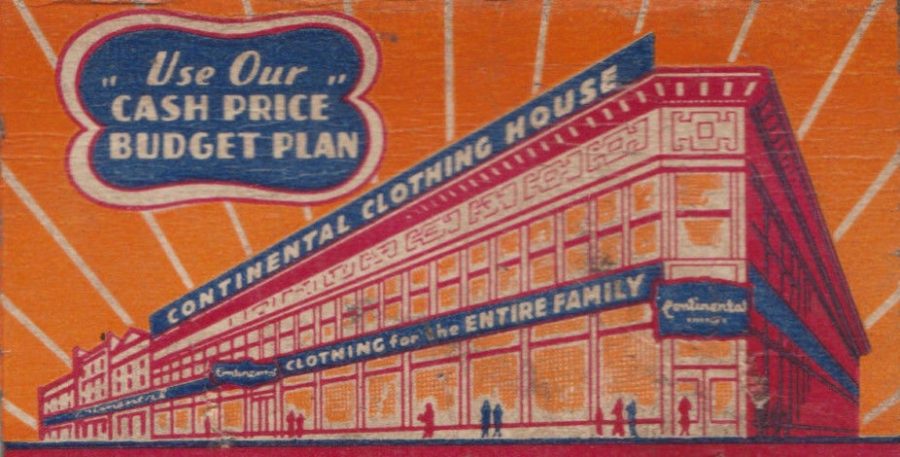
Matchbook graphic for Continental Clothing
The early growth of these industries flourished with the arrival of new immigrants, as described in a 1921 Economist article:
Milwaukee Avenue, notably the great centers created by the intersecting thoroughfares, is a stable investment because of the fact that it is an active business thoroughfare; because further it is backed up by an industrious and thrifty class of people who save their money and pay their bills; moreover there are so many of them and they are so dependable that the big merchants have made themselves big by supplying their wants in the way of substantial merchandise at low prices. This is what is making Milwaukee Avenue the substantial center it is for the transaction of general business.
—The Economist, describing a land transaction involving Continental Clothing at Milwaukee and Ashland, 1921
An Evolving Study of Housing Types
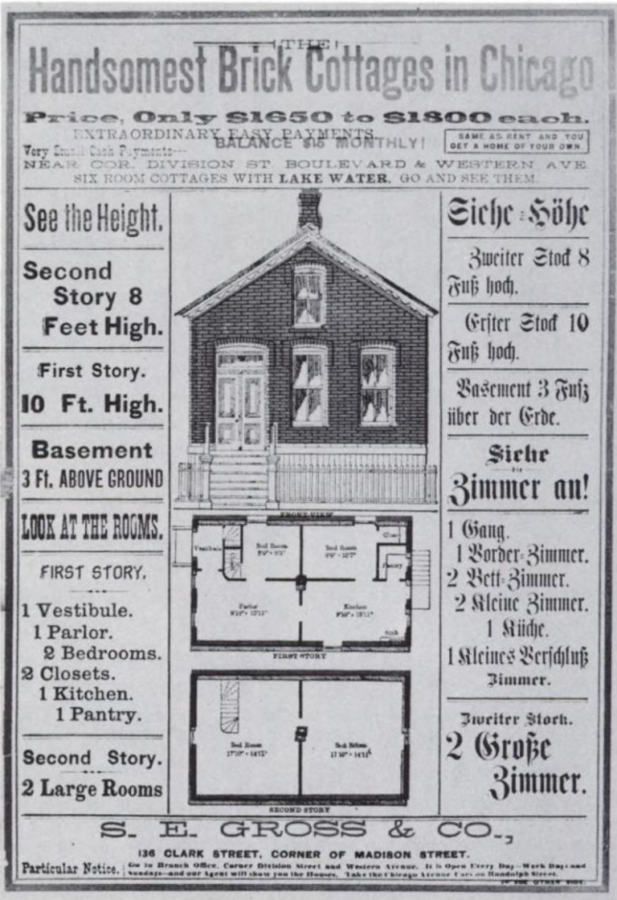
1870s-1890s: The Worker’s Cottage Offers a Solution for Deplorable Living Conditions
For many who worked in Chicago factories at the turn of the 20th century, housing conditions were deplorable, particularly near the center of the city. Tenement and boarding houses as documented by two reporters in 1893 for Vorbote, a Chicago-based German newspaper:
In the bedroom there was nothing to be seen save the nearby berths just below the ceiling. These were about two feet wide and were comprised of the plank base, a straw mattress, and a blanket. The bed things look as though they had been dragged around a stockyards and then washed in the Chicago River. Rodents also made their home here, something which could be quickly ascertained.
–Nocturnal Infernos, Vorbote, November 27, 1893 (describing tenement housing)
The Worker’s Cottage, a 1 and 1/2 story house with a gabled roof, was marketed as an affordable way to escape the living conditions in poorly maintained tenement houses. Many of these appeared on the streets connecting to Milwaukee Avenue, as workers left the center city in search of a better life.
![Workers Cottage at Moffat and Winnebago, one block from Milwaukee Avenue. [John Morris/Chicago Patterns]](http://chicagopatterns.com/wp-content/uploads/2016/06/cottage-900x600.jpg)
Workers Cottage at Moffat and Winnebago, one block from Milwaukee Avenue. [John Morris/Chicago Patterns]
Unfortunately, the modest workers cottage receives barely any appreciation today. But during the time of its proliferation across Chicago, it was an almost palatial estate compared to the overnight hotels and boarding houses: 10 ft. ceilings, large rooms, and basements above ground level.
![Italianate row homes at Wolcott and Wicker Park Avenue [John Morris/Chicago Patterns]](http://chicagopatterns.com/wp-content/uploads/2016/06/rowhome-1-900x600.jpg)
Italianate row homes at Wolcott and Wicker Park Avenue [John Morris/Chicago Patterns]
1870s-1880s: Early Multifamily in Italianate Row Homes
Appearing as a slightly taller variant of the Worker’s Cottage, multistory Italianate row homes appear along residential side streets of Milwaukee Avenue closer to the city center.
Many were separate units, allowing owner-occupied rentals. Similar to the Worker’s Cottage, older row homes are becoming more scarce as larger single family homes take their place.
![Mansion at Hoyne and Le Moyne featuring elements of Second Empire, Italianate, and Queen Anne styles [John Morris/Chicago Patterns]](http://chicagopatterns.com/wp-content/uploads/2016/06/hoyne_mansion-900x600.jpg)
Mansion at Hoyne and Le Moyne in Wicker Park featuring elements of Second Empire, Italianate, and Queen Anne styles [John Morris/Chicago Patterns]
1870s-1900s: Victorian Mansions for “New Money” Immigrants
Many new immigrants sought out their fortune in Chicago, and a few found it. They were considered “new money” by the established elite and wealthy residents of the South and West sides. This label barred them from building homes there, so they chose areas along boulevards and near parks for their grand homes.
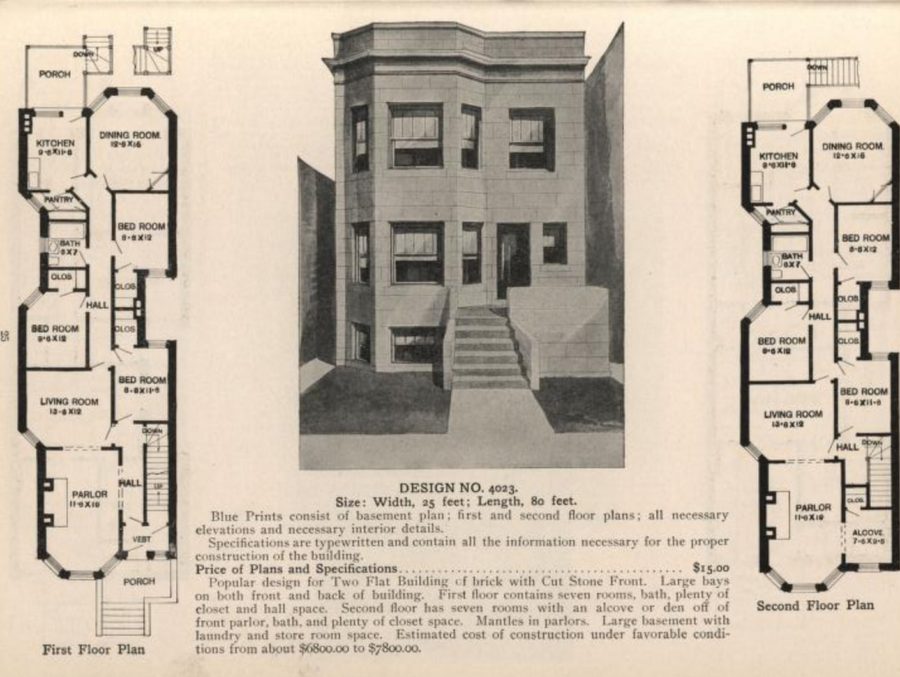
Floorplan for a typical Chicago greystone, from Radford’s Stores and Flats catalog, 1909
1890s-1920s: The Staple of Style and Practicality: The Greystone Two/Three-Flat
There are few buildings which represent early housing in Chicago as much as the greystone two or three-flat. Living in a two/three-flat proved then as it does now to be a wise investment: friends, relatives, or tenants pay part or all of the mortgage.
![Greystone three-flats at Milwaukee and California [John Morris/Chicago Patterns]](http://chicagopatterns.com/wp-content/uploads/2016/06/milwaukee-14-900x600.jpg)
Greystone three-flats at Milwaukee and California [John Morris/Chicago Patterns]
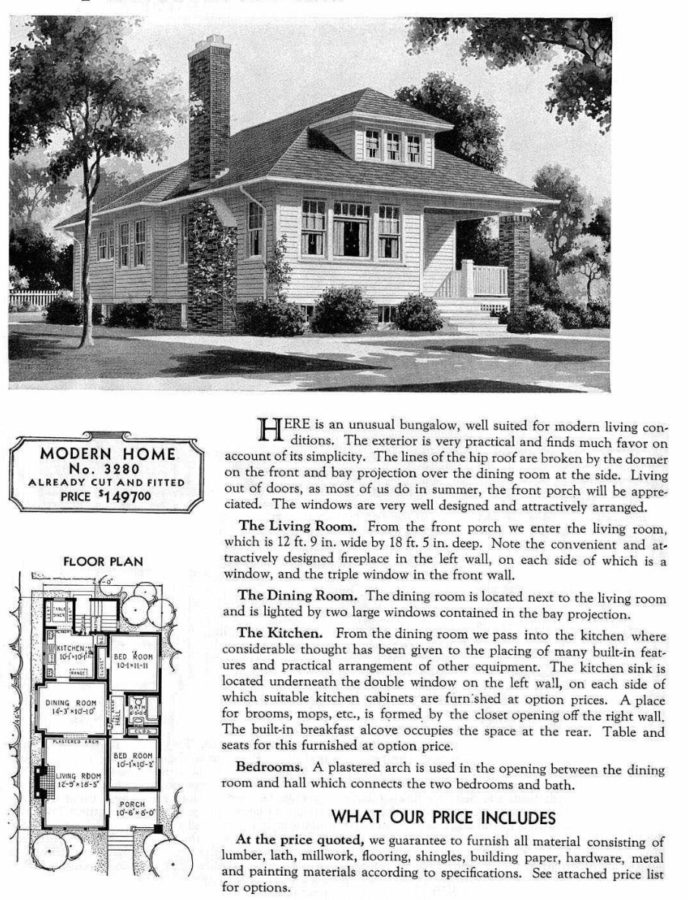
The Collingwood, a late 1920s Bungalow plan from Sears
1900s-1920s: The New Sign of “Making It” — The Bungalow
As you leave the center city and head past Avondale, the prevalence of two and three-flats starts to give way to single family housing, frequently in the form of the Chicago Bungalow.
![4856 Byron Avenue, near the Cicero/Milwaukee/Irving Park intersection [John Morris/Chicago Patterns]](http://chicagopatterns.com/wp-content/uploads/2016/06/byron-900x600.jpg)
4856 Byron Avenue, near the Cicero/Milwaukee/Irving Park intersection [John Morris/Chicago Patterns]

Plans for an American Four Square house, from Radford’s Stores and Flats Catalog
1900s-1930s: A Distinctly American Style: the American Four Square
The American Four Square, like its smaller sibling the Bungalow, features a symmetrical appearance and a sparsely decorated exterior. They could serve as a single family
home, or as in the plans above, a multi-unit building where each unit features two stories of living.
![American Four Square house at Milwaukee and Warner [John Morris/Chicago Patterns]](http://chicagopatterns.com/wp-content/uploads/2016/06/four-900x599.jpg)
American Four Square house at Milwaukee and Warner in Portage Park [John Morris/Chicago Patterns]
Nickelodeons, Theaters, and Movie Palaces
A Chicago Tribune article from Dec. 13, 1912, mentions that 635 theaters of all sizes and classes operated in the city. Many were on Milwaukee Avenue, and a few buildings remain today, serving as a link to the cinematic past of a century ago.
1900s-1910s: The Nickelodeon Era
Before the large movie palaces, nickelodeons gave neighborhoods a movie experience. Most were small rectangular rooms with few amenities. Also known as “loft theaters,” they were in neighborhood buildings and charged five cents for admission.
Nickelodeons burst on the scene rapidly, expanding into all neighborhoods and cities across the country. They disappeared rapidly as Hollywood integrated movie making and the places showing films. For more history of nickelodeons, see our previous post, Avondale’s Forgotten Nickelodeon: The Enterprise.
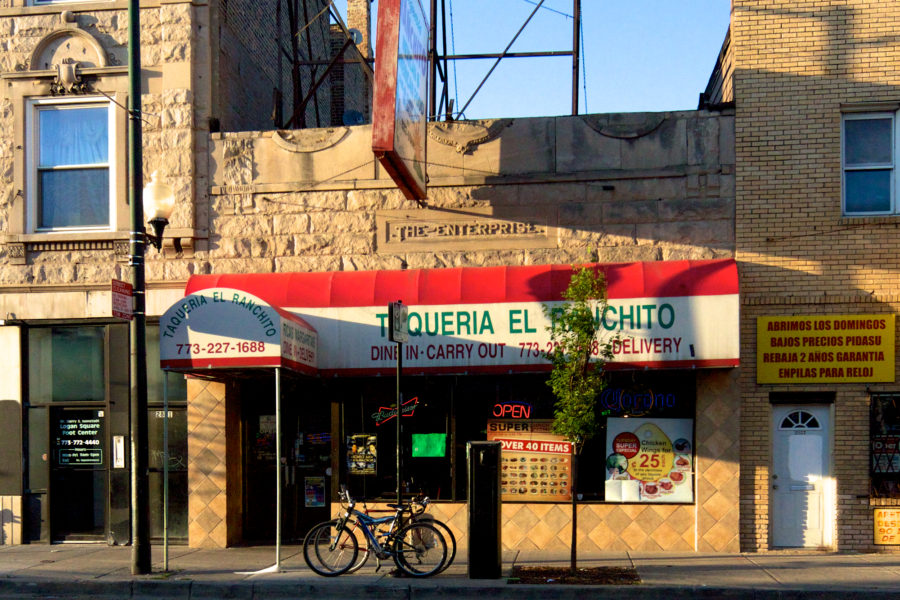
The Enterprise, a short-lived nickelodeon on Milwaukee Avenue in Avondale [John Morris/Chicago Patterns]
One surviving and interesting remnant of the Nickelodeon Era is The Enterprise (above) in Avondale. Originally a multistory and multi-use building, today all that remains is the first floor.

Jefferson Theater [John Morris/Chicago Patterns]
According to Cinema Treasures, the Jefferson Theatre at Milwaukee and Lawrence opened in 1914 with a capacity of 294. It was renamed the Progress Theatre in 1917 before ultimately closing in 1923.
![Brickwork with "Jefferson" revealing the history of this otherwise ordinary appearing building [John Morris/Chicago Patterns]](http://chicagopatterns.com/wp-content/uploads/2016/06/jefferson-900x600.jpg)
Brickwork with “Jefferson” revealing the history of this otherwise ordinary appearing building [John Morris/Chicago Patterns]
![Home Theater [John Morris/Chicago Patterns]](http://chicagopatterns.com/wp-content/uploads/2016/06/home_theater-900x600.jpg)
Home Theater [John Morris/Chicago Patterns]
The Home Theater (also known as Home 5 Cent Theater) at 1539 N. Milwaukee opened in 1912, and is a beautiful extant example of the transition between the storefront theater era and the age of the dedicated movie theater.
Most nickelodeons were storefronts converted with chairs and a projector, but the Home Theater was designed specifically for this purpose.
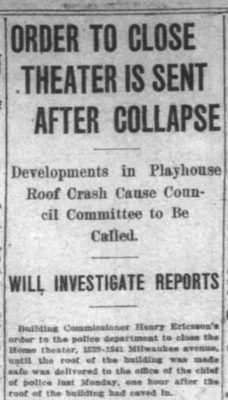
December 11, 1912, Chicago Inter Ocean detailing roof collapse of Home Theater
The Home Theater on Milwaukee became infamous for an engineering disaster which put the architect and engineer of the building in the hot seat after the roof collapsed. Newspaper accounts of the time called it “perilous” or a “deadly disaster,” but there isn’t mention of anyone actually losing their life in the accident.
The architect, David Saul Klafter, faced a lawsuit and public hearings were held over inspections and the design. He was eventually cleared of all wrongdoing, and the theater was renamed “Bell Theater” in 1914.
Today it is home to John Fluevog Shoes.
1910s to 1940s: The Movie Palace Era
The First World War and Hollywood’s integration of movie houses and film production marked a quick end to Nickelodeon era of movie theaters in 1915.
By the 1920s, the experience of watching a motion picture evolved from a makeshift storefront with chairs and a projector to a purpose-built structure that dazzled with exterior ornament and provided a comfortable movie watching experience.
![Chopin Theatre in 2014 [John Morris/Chicago Patterns]](http://chicagopatterns.com/wp-content/uploads/2016/06/chopin-900x600.jpg)
Chopin Theatre in 2014 [John Morris/Chicago Patterns]
While the Home Theater served as the close of the nickelodeon era, Chopin Theater represented an entry to the new era of movie palaces. Facing the intersection of Milwaukee, Division, and Ashland, Chopin Theatre is an important link to theatrical history:
The building of the Chopin Theatre was designed in 1918 by M.F. Strunch Architects as a 987 seat theater at 1541-1543 W. Division. According to the Theatre Historical Society of America, the theatre’s name has changed several times over the years from Chopin Theatre to Harding Theatre, back to Chopin Theatre and then to the Pix Theatre from 1940-1948. During the next 40 years it went through a number of alternate uses: Security Federal Savings and Loan; thrift shop, discotheque, etc. In 1990 the vacant building was purchased by the Dyrkacz family and gradually restored. Today it houses a Main Stage (226), Cabaret Studio (50-100) with its Pregnant Buffalo Lounge, the Nelson Algren Café, East Wing Art Gallery and the office/residence of owners Zygmunt and Lela Dyrkacz.
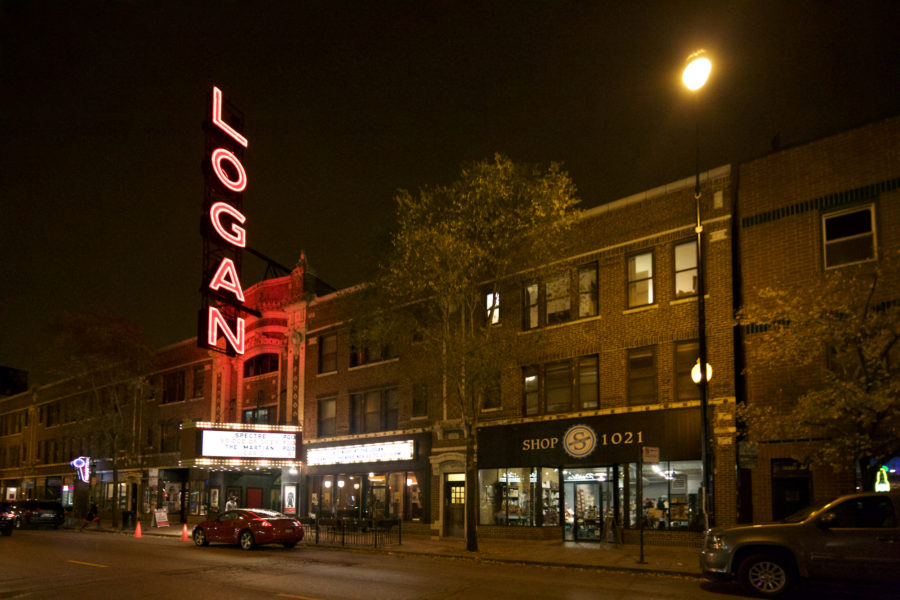
Night view of Logan Theatre [John Morris/Chicago Patterns]
The Walter Ahlschlager designed Logan Theatre opened in 1915 in Logan Square. Renovations in 2012 revealed original interior Art Deco detailing.
The Logan Theatre is captured in the first article published here, in Introducing Chicago Patterns, outlining the meaning of the name and goals of this project.
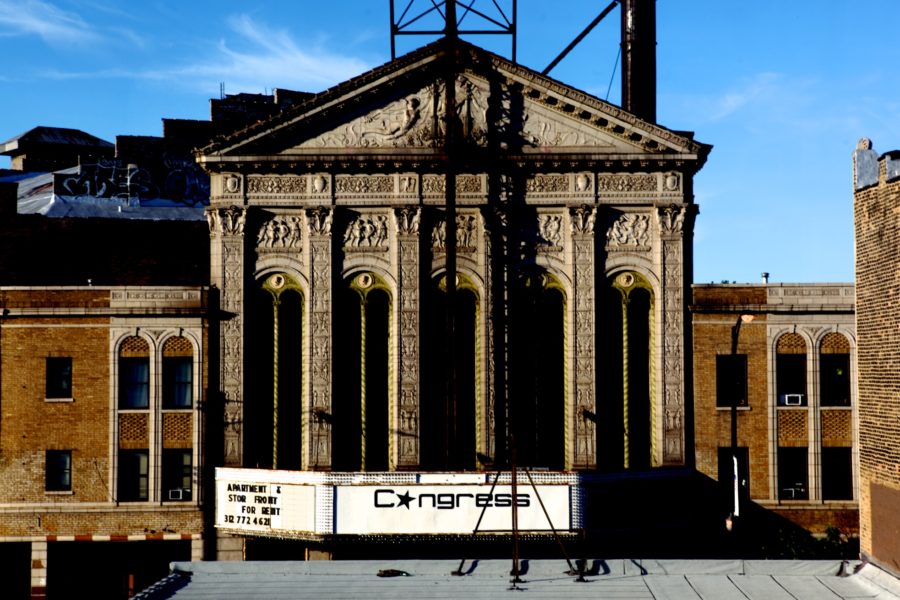
Congress Theater in 2013 [John Morris/Chicago Patterns]
The Congress Theater
In 1926, at the height of the movie palace era, the Congress Theatre opened to parades, a beauty contest, among other events.
Prior to closing in 2013, it served as a music and event venue. After a series of dramatic neighborhood debates and disputes, new owners announced a $55 million renovation plan. The new owners are currently seeking a National Register nomination.
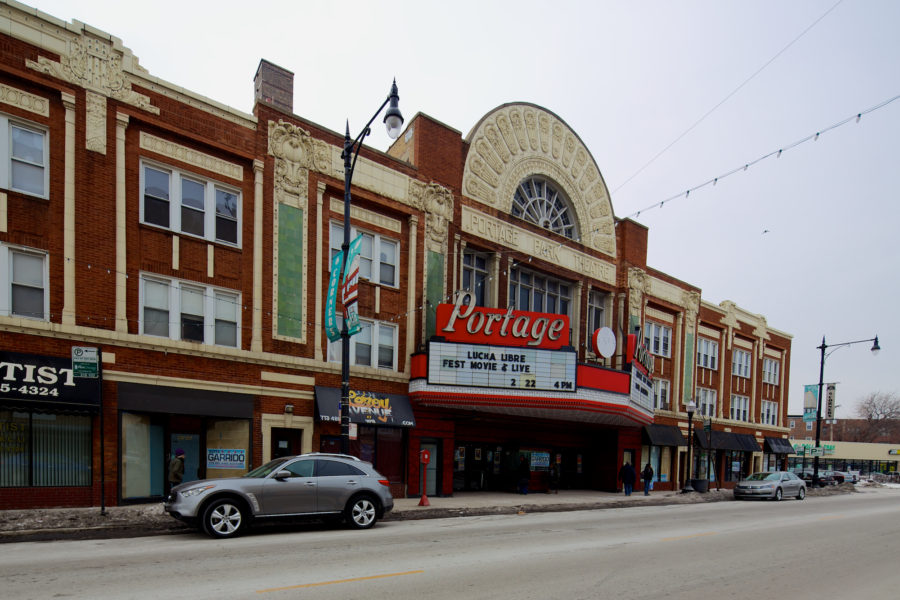
The Portage Theater [John Morris/Chicago Patterns]
The Portage Theater
Portage Theater, the outermost theater in this Milwaukee Avenue history tour, is also one of the oldest in the city.
It opened in 1920 with a Classical exterior and megaphone-shaped interior, before undergoing renovations in 1940 which added Art Deco styling to the interior lobby and entryway.
Milwaukee Avenue After “Dinner Pail Avenue”
The evolution of architecture styles and types, with the study of immigration patterns of Milwaukee Avenue tell a story of arrival and social advancement. The next two parts in this series will highlight its status as a living history book of organically-derived Chicago architecture and later, the arrival of Art Deco and the Machine Age.
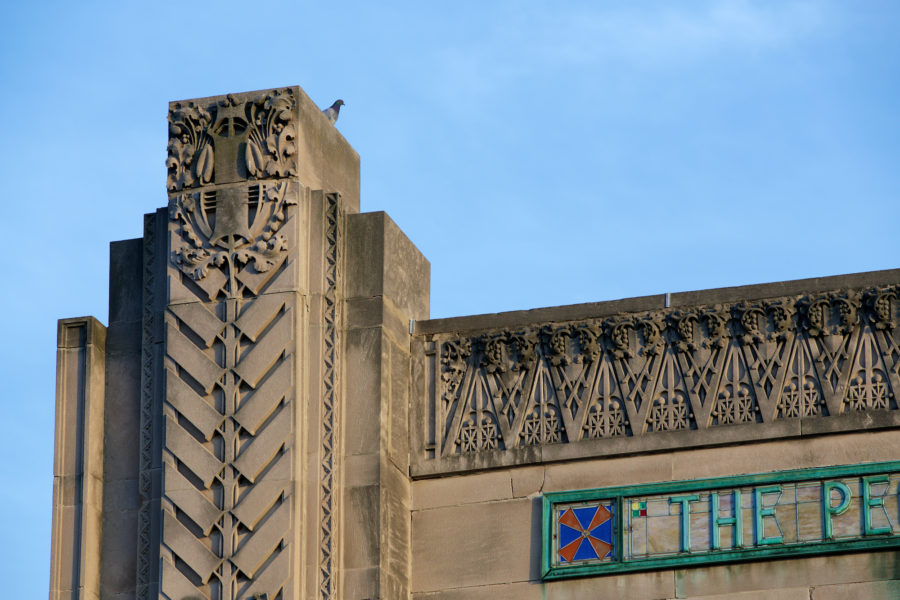
Detail of the 1926 Peoples Gas Irving Park Neighborhood Store, designed by George Grant Elmslie and Hermann V. von Holst
Part 2: The Chicago School and Arrival of Sullivanesque
In the next article, we’ll explore architecture of the Chicago School along Milwaukee that arose around the turn of the century, as well as the later Sullivanesque style that bloomed along Milwaukee in the 1920s.

Art Deco detail on Milwaukee Avenue in Logan Square [John Morris/Chicago Patterns]
Part 3: Transition to Art Deco and the Machine Age
In part 3, we’ll look at how the built environment evolved from the heady days of the late 1920s, the Great Depression and the post-World War II era.
This era created a legacy modern design. The transition from classically inspired buildings to modern and futuristic design is unique in American history.
There is much more to come on Chicago Patterns with regard to this history of Milwaukee Avenue. If you have memories, photos, or information about Milwaukee Avenue, please let us know in the comment section.
Related Articles
- Chicago’s Forgotten Turner Halls: Turnverein Vorwaerts
- Avondale’s Forgotten Nickelodeon: The Enterprise
- Goodbye, Gray Buildings at Milwaukee/Grand/Halsted
References and Further Reading
- Paved or unpaved, Milwaukee Avenue always vital to northeast Illinois (Wheeling Historical Society)
- Milwaukee Elevated (chicago-l.org)
- National Register Landmark Nomination for Carl Schurz High School (Internet Archive)
- Norwegians of Chicago (Encyclopedia of Chicago)
- Poles in Chicago (Internet Archive)
- Jefferson Park (Northwest Chicago Historical Society)
- Milwaukee Avenue [PDF] (NW Chicago Historical Society Newsletter)
- 100 years of Chicago bungalows (WBEZ)


Excellent article showing the progression of Milwaukee Ave. There are still some remnants in the suburbs of the name Indian Trail especially in Lake County.Thank you for highlighting some of the architectural high points along the way. So many are lost amidst the billboards and neon signs and other visual “debris”.
I am looking for a picture of 777 n Milwaukee in the late 60’s – 1968 specifically. Kuriyama was established in this location and doing a 50 year anniversary
My great grandparents owned a polonia restaurant around Milwaukee Avenue. (possibly north Milwaukee Avenue) Thank you!
Hi, looking for a photo of the 1st place i worked as a teenager @1971-72, it was a furniture/music store, i think it was in the flat-iron building; want to get any pics or info about the place, cannot remember the exact name-‘Emerald Furniture'(muebleria) anyone recall this place?? appreciate any info you have!